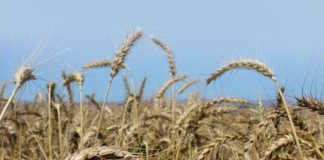The seedbed for planting dry beans must be deep, level and firm. This ensures better contact between seed and soil, increasing moisture absorption. Place seeds 2,5cm to 5cm below the soil surface. Weed control Being low-growing plants, dry beans struggle to compete with weeds. Early weed control is thus very important. Some weeds secrete chemicals that limit bean plant growth, and weeds also hamper harvesting and threshing later on, affecting the quality of the crop.
Remove all weeds mechanically during seedbed preparation, and repeat with a tiller between the rows when necessary up to the flowering stage. This will also loosen the soil and improve water penetration. Several herbicides control weeds throughout the growing period – speak to your agrochemical rep.
Harvesting
Dry beans are ready for harvesting when the moisture content drops to 15% (the ideal) or 16%. Seeds may split during threshing when the moisture content is less than 12%. Such seeds are rejected by canners and seed companies. Harvest when all the pods have turned yellow, but before they have become so dry that the pods begin to shatter.
Harvesting Methods
- Hand-pulling and threshing by driving a tractor over the beans on a threshing floor. Smaller volumes can be threshed by hand by beating with a stick in a hessian sack. The wind can also be used to separate the seed from the chaff.
- Partially mechanised systems, where the plants are pulled up by hand, placed in windrows and threshed with a harvester or stacked for threshing with a stationary threshing machine.
- An automated system with mechanical pulling. The beans are raked into windrows and threshed by an automated combine.
Some tips
- To prevent shattering, beans should be pulled when the moisture content of the pods is temporarily higher – that is, early in the morning before the dew has evaporated.
- Mechanised harvesting must be done when there is no danger of crop damage by rain.
- To prevent cracking and splitting, beans should be threshed at slow cylinder speeds with a machine equipped with an axial flow threshing mechanism.
Source: Dry Bean Production, edited by Dr AJ Liebenberg (Directorate Agricultural Information Services, department of agriculture, in co-operation with the ARC-Grain Crops Institute)













